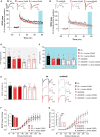Astrocytes control hippocampal synaptic plasticity through the vesicular-dependent release of D-serine
- PMID: 38145284
- PMCID: PMC10740624
- DOI: 10.3389/fncel.2023.1282841
Astrocytes control hippocampal synaptic plasticity through the vesicular-dependent release of D-serine
Abstract
Astrocytes, the most abundant glial cells in the central nervous system (CNS), sense synaptic activity and respond through the release of gliotransmitters, a process mediated by intracellular Ca2+ level changes and SNARE-dependent mechanisms. Ionotropic N-methyl-D-aspartate (NMDA) receptors, which are activated by glutamate along with D-serine or glycine, play a crucial role in learning, memory, and synaptic plasticity. However, the precise impact of astrocyte-released D-serine on neuronal modulation remains insufficiently characterized. To address this, we have used the dominant negative SNARE (dnSNARE) mouse model, which selectively inhibits SNARE-dependent exocytosis from astrocytes. We recorded field excitatory postsynaptic potentials (fEPSPs) in CA3-CA1 synapses within hippocampal slices obtained from dnSNARE mice and wild-type (Wt) littermates. Our results demonstrate that hippocampal θ-burst long-term potentiation (LTP), a critical form of synaptic plasticity, is impaired in hippocampal slices from dnSNARE mice. Notably, this LTP impairment was rescued upon incubation with D-serine. To further investigate the involvement of astrocytes in D-serine-mediated mechanisms of LTP maintenance, we perfused hippocampal slices with L-serine - a substrate used by both neurons and astrocytes for D-serine production. The enhancement in LTP observed in dnSNARE mice was exclusively associated with D-serine presence, with no effects evident in the presence of L-serine. Additionally, both D- and L-serine reduced basal synaptic strength in the hippocampal slices of both Wt and dnSNARE mice. These results provide compelling evidence that distinct processes underlie the modulation of basal synaptic transmission and LTP through D-serine. Our findings underscore the pivotal contribution of astrocytes in D-serine-mediated processes that govern LTP establishment and basal transmission. This study not only provides essential insights into the intricate interplay between neurons and astrocytes but also emphasizes their collective role in shaping hippocampal synaptic function.
Keywords: astrocyte; d-serine; gliotransmission; synaptic plasticity; tripartite synapse.
Copyright © 2023 Abreu, Gomes, Ribeiro, Diógenes, Sebastião and Vaz.
Conflict of interest statement
The authors declare that the research was conducted in the absence of any commercial or financial relationships that could be construed as a potential conflict of interest.
Figures




References
LinkOut - more resources
Full Text Sources
Molecular Biology Databases
Miscellaneous

